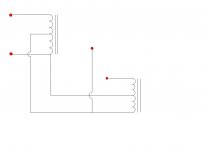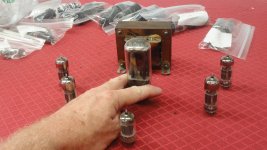I think I know the answer already, I'm trying to get my B+...I have a large enough transformer core to rewind to get an isolation type TX but wire in bulk is virtually impossible to find & a reel of suitable wire is god-awful priced. Plus the 'old' bobbin got roasted. Bouncing around ideas, would back to back autotransformers work for this application? Autotransformers here are a dime a dozen. If not I'll be chasing around for wires till the cows come home.
_____________________________________________________Rick..........
_____________________________________________________Rick..........
Attachments
How about unwinding one of those to get the wire you need?Autotransformers here are a dime a dozen.
There´s usually not enough room on the bobbin to rewind an autoformer with an additional winding.
Check if they have soldered the different parts of the winding outside the bobbin.
Then you can split the windings and connect 2 transformers for an 1:1 isolation.
It´s not as safe as a regular isolation tx since wire insulation is the only thing making insulation.
Check if they have soldered the different parts of the winding outside the bobbin.
Then you can split the windings and connect 2 transformers for an 1:1 isolation.
It´s not as safe as a regular isolation tx since wire insulation is the only thing making insulation.
Last edited:
As high voltage transformers are becoming "Audiophile" and "Expensive", why not try Back-Backing simple mains transformers.
For example.
If you have two 115+115 / 12 transformers.
I'm assuming that you have 115V mains.
Parallel the primaries of the first transformer.
Connect the secondary to the secondary of the second transformer.
The primaries of the second transformer will then have 115V each on them.
In series they will provide 240V AC or 340V DC.
For example.
If you have two 115+115 / 12 transformers.
I'm assuming that you have 115V mains.
Parallel the primaries of the first transformer.
Connect the secondary to the secondary of the second transformer.
The primaries of the second transformer will then have 115V each on them.
In series they will provide 240V AC or 340V DC.
As high voltage transformers are becoming "Audiophile" and "Expensive", why not try Back-Backing simple mains transformers.
For example.
If you have two 115+115 / 12 transformers.
I'm assuming that you have 115V mains.
Parallel the primaries of the first transformer.
Connect the secondary to the secondary of the second transformer.
The primaries of the second transformer will then have 115V each on them.
In series they will provide 240V AC or 340V DC.
Right but the transformers will be very hot soon due the big current flowing between the secondaries.
To reduce the heat yuo have to reduce the current, so don't use 12V secondary but a voltage as hight as you can. More is better.
I didn't know that :/An auto transformer can be wired to increase or decrease the output voltage relative to input voltage.
Apart from not having a secondary, do they work like normal transformers (increasing voltage by decreasing current and vice-versa)?
Right but the transformers will be very hot soon due the big current flowing between the secondaries.
To reduce the heat yuo have to reduce the current, so don't use 12V secondary but a voltage as hight as you can. More is better.
The pro of using a 12v is that you get a free 12v heater supply.
The first transformer higher VA rated compensating for what heaters need.
You can always go higher and use series heaters.
What they do is use the flux from the "bottom" part of the winding (i.e., the part that's energized from the AC input) to create voltage in the "top" part of the winding, which is then added to the original input voltage. But as Andrew points out, they do NOT isolate, and using them for power transformers is dangerous to the point of being stupid.
Proper HV transformers are still relatively inexpensive and easy to get (a few minutes on EBay will be productive- I've been using Antek toroids; surplus dealers like Apex Jr often have excellent transformers at very good prices). Likewise, back-to-back LV transformers can work and still provide the absolutely essential isolation that you need for basic safety.
Proper HV transformers are still relatively inexpensive and easy to get (a few minutes on EBay will be productive- I've been using Antek toroids; surplus dealers like Apex Jr often have excellent transformers at very good prices). Likewise, back-to-back LV transformers can work and still provide the absolutely essential isolation that you need for basic safety.
I've used industrial transformers (120 & 240 : 240 & 480) which you often find cheap on Ebay. Just make sure you get one with a big enough VA rating. Shipping costs may be an issue because the bigger ones are heavy.
It's pretty easy to get approximately 300v or 600v out of one.
Also consider voltage doubler circuits if you have a suitable transformer.
ray
It's pretty easy to get approximately 300v or 600v out of one.
Also consider voltage doubler circuits if you have a suitable transformer.
ray
Right but the transformers will be very hot soon due the big current flowing between the secondaries.
To reduce the heat yuo have to reduce the current, so don't use 12V secondary but a voltage as hight as you can. More is better.
If there is no load on the final windings there will be no current between the two transformers, as long as the secondaries are rated at the same voltage.
Simplistic, I appreciate that there will be the magnetising current which is minimal.
I think you need to read up on transformer theory.
What you are saying is akin to saying that any transformer will overheat with the correct voltage applied - utter rubbish.
Last edited:
Ok, Just as I thought....And yes running two 220-12 Txs back to back has been on my mind. So.....I'll get two 220-12@4A, run back to back....From there I will tap off the 12V for the quad of 12B4s'. I do have a small 220-12? TX, not big enough to drive all the heaters, but it is a split bobbin type. I'll have that one run thru a 317 for the 12AU7 on the front end....and the 12V tapped off the B2B for the 12B4s. From there I will still need a 5V for the 5U4GB.
A spare autotransformer for a choke??? Great idea, I have those...
______________________________________________________Rick..........
A spare autotransformer for a choke??? Great idea, I have those...
______________________________________________________Rick..........
Attachments
- Status
- This old topic is closed. If you want to reopen this topic, contact a moderator using the "Report Post" button.
- Home
- Amplifiers
- Tubes / Valves
- Back to back autotransformers for B+?

